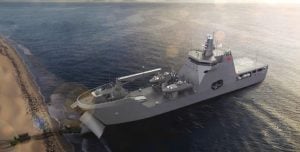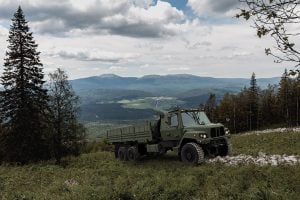74th Indian Army Infantry Day
- Top Indian Army officials were seen in New Delhi at the National War Memorial on Tuesday. The officials had gathered on the occasion of Infantry Day.
- Chief of Defence Staff General Bipin Rawat, Army Chief Manoj Mukund Naravane were seen at the National War Memorial. The officials paid tribute at NWM.
- Indian Army observes Infantry Day every year on October 27 to mark the landing of first Indian troops in Jammu and Kashmir. The troops were airlifted from Delhi to Srinagar to push back Pakistan supported intruders in 1947.
Raksha Mantri Shri Rajnath Singh holds bilateral delegation level meeting with his US counterpart Mark Esper; Both aides to sign agreement of BECA during the visit
- Dr. Mark T. Esper, Hon’ble Secretary of Defence of the United States of America is visiting India for the 2+2 Ministerial Meeting. Today Shri Rajnath Singh, Hon’ble Raksha Mantri had a bilateral meeting with him in South Block, New Delhi. The two ministers reviewed bilateral defence cooperation spanning military to military cooperation, secure communication systems and information sharing, defence trade and industrial issues and also discussed ways to take bilateral cooperation forward.
- Both the Ministers expressed satisfaction at the close engagements between the respective Armed Forces. They discussed potential new areas of cooperation, both at Service to Service level and at the joint level. They called for continuation of existing defence dialogue mechanisms during the pandemic, at all levels, particularly the Military Cooperation Group (MCG). They also discussed requirements of expanding deployments of liaison officers.
- The two ministers expressed satisfaction that agreement of BECA will be signed during the visit. US Secretary of Defence welcomed Australia’s participation in the exercise MALABAR 2020.
- Hon’ble Raksha Mantri elaborated upon the initiatives under the ATMANIRBHAR BHARAT to encourage investments in the defence industry in India and invited US companies to make avail of the liberalized policies and the favorable Defence Industry ecosystem in India.
Myanmar army launches Operation Sunrise-3 to crackdown insurgent groups at Indo-Myanmar border
- Myanmar army has launched Operation Sunrise-3 to crack down on various insurgent groups gathered at the Indo-Myanmar border. National Socialist Council of Nagaland-Khaplang (NSCN-K), led by Yung Aung, is consolidating its position inside Myanmar and various NSCN groups are planning to attack Indian security forces at vulnerable points in the North East region.
- Indian foreign secretary Harsh Shringla and Indian Army Chief General Manoj Mukund Naravane were on a two-day visit to Myanmar this month. It is said that talks were held between the two countries about joint actions against insurgents groups operating in the North East regions and in Myanmar.
- “Specialized Myanmar Army units are engaged to carry out combing operations in search of NSCN-K and other groups at various places in the Sagaing region of Myanmar. Infantry units of the Myanmar army is also carrying out operation towards the eastern side of Manipur river,” said an Indian Security officer aware of these developments.
- The Operation Sunrise-3 of the Myanmar Army in the Sagaing Division is mainly due to the latest input of insurgents groups consolidating it’s position from Sagaing and other areas to Northern Chin state. The security agencies of both countries are apprehensive that the insurgent’s groups along the Indo-Myanmar border are conspiring to infiltrate into the Indian side through the Mizoram border.
- Last year, Myanmar and Indian Army had carried out the first phase of ‘Operation Sunrise -1’ between February 17 and March 2 and a three-week-long coordinated operation named ‘Operation Sunrise 2’ on May 16 in its own territory along the Indo-Myanmar border. It is said to have destroyed many camps of insurgent groups. However, the Myanmar Army is also reported to have suffered a loss in the second phase of ‘Operation Sunrise 2’.
- At least 13 soldiers of the Myanmar Army lost their lives in clashes with the Rakhine insurgent group Arakan Army.
- Despite the joint operation by both armies, the Insurgent group Arakan Army has set up several camps in areas across Mizoram’s Lawngtlai district, posing a threat to the Kaladan Project.
- The Kaladan multi-modal transit transport project is being viewed as India’s gateway to Southeast Asia. India entered into a framework agreement with Myanmar in April 2008 to facilitate the implementation of the project. On completion, the project will help connect Mizoram with the Sittwe Port in the Rakhine State of Myanmar. On the Indian side, work is on to extend the Aizawl-Saiha National Highway by 90 km to the international border at Zorinpui.
- “Arakan Army has set up various camps along the Indo-Myanmar Army border. Indian agencies are continuously monitoring the developments at Indo-Myanmar border.”
- According to officials tracking India’s border along with Myanmar. There are over 50 camps of insurgent groups reported from the north-east in Myanmar till 2018.
- The Myanmar military handed over a group of 22 insurgents, active in Assam and northeast states, to the Indian government this year in May. The insurgents, wanted in Manipur and Assam for a long time, were brought back by a special plane. This was the first time when the Myanmar government had acted on India’s request to hand over the leaders of the northeast insurgents groups. Among those who were deported by the Myanmar government, 12 are linked with UNLF, PREPAK (Pro), KYKL, and PLA whereas the remaining 10 are associated with Assam groups such as NDFB(S) and KLO.
- The insurgents groups active across India’s northeast states and at the Indo-Myanmar border are taking advantage of the large scale of unemployment caused by the outbreak of the COVID-19 pandemic and are conspiring to recruit more youth into their outfits. A large number of NSCN (K) cadres congregate along the Indo-Myanmar Border across the Mon area (Nagaland) with a motive to carry out attacks on Security Forces.
India to get 5 military theatre commands, one each for China and Pak
- with defined areas of operation and a seamless command structure for synchronised operations.
- With the department of military affairs soon to have additional and joint secretaries after Cabinet clearance, the task of reorganisation of the three services under theatre commands has begun with a China specific Northern Command and Pakistan specific Western command under serious consideration. India’s Chief of Defence Staff Gen Bipin Rawat has been given the mandate by the Narendra Modi government to create theatre commands much like the ones China and the US currently have.
- According to military and national security planners, the northern command’s remit will begin from the Karakoram Pass in Ladakh and continue up to the last outpost Kibithu in Arunachal Pradesh , with the military mandate of guarding the 3,488 kilometre of Line of Actual Control (LAC) with China. The HQ of this command could be Lucknow.
- The western command’s remit will be from Indira Col on Saltoro Ridge in the Siachen Glacier region to the tip of Gujarat with its HQ likely in Jaipur.
- The third theatre command will be the Peninsular Command; the fourth, a full-fledged air defence command; and the fifth, a maritime command. The likely HQ of the Peninsular command could be Thiruvananthapuram. The air defence command will not only spearhead the country’s aerial attack but also be responsible for defending Indian airspace through multi-role fighters with all anti-aircraft missiles under its control.
- Currently, the Indian Army, Indian Air Force and the Indian Navy all defend Indian airspace on separate communication frequencies and without synergy. This is despite the fact that all Indian Army Corps Headquarters are located next to an air base as a result of which there is duplication of effort and wasteful expenditure.
- The planners said there is option of extending this to an aerospace command as per future requirements.
- India will have only one maritime command with a possibility that the tri-service Andaman and Nicobar Islands Command being merged with this. The task of the maritime command will be to protect the Indian Ocean and India’s Island territories as well as keep the sea lanes free and open from any outside pressure.
- Although in a nascent stage, the Indian Navy’s maritime assets will be placed in Karwar on the western seaboard, Vishakhapatnam on the eastern seaboard and in the Andaman and Nicobar Islands. With China emerging as a threat, the possible headquarters of the Maritime Command could be Andhra Pradesh’s new capital with Port Blair emerging as another major base for naval operations.
- Theaterisation refers to placing units of the army, air force, and navy under a single Theatre Commander. The operational command of such combinations will be under one officer drawn from one of the three services.
- “Theaterisation of commands is imperative to integrate resources of the three services for maximising impact in any war. The geographical expanse of theatres in India demands unified commands for strategic decisions and critical outcomes that will be possible in concentrated employment of resources,” said former army vice chief Lt Gen AS Lamba (retd).
- According to senior officials familiar with the matter, all five commands will be headed by Lt General or equivalent rank commanders, who will be the first among equals with the heads of the present commands reporting to them. The task of the Chief of Staff of Army, Chief of Air Staff and Chief of Naval Staff will not be operational but involve mobilising resources to the theatre commanders as it is in the US military.
- If the Andamans and Nicobar Command goes under the maritime command as is being visualised, then the CDS will have the Armed Forces Special Operation Division, Cyber Command and the Defence Intelligence Agency under him with manpower drawn from all the three services.
The US Navy Adds More Muscle to Its Arsenal; Goes Hypersonic
- In making a significant policy and operational change to its military doctrine, the US Navy has unveiled plans to equip all its destroyers with hypersonic missiles.
- Beset with project cost overruns and delays for quite some time, the US navy is currently faced with an increasingly aggressive and assertive Chinese Navy that has forced it to bring about a big deal of functional improvements to maintain its lead over the arch-rival Russia and the emerging one, China.
- Currently, the US Navy with 293 ships is the most formidable naval force in the world. Though very recent estimates suggest that the PLA Navy (China) has 350 battle force ships yet in terms of real power, technological strength, naval airpower, nuclear missiles, submarines, destroyers, global outreach and power projection, the US Navy continues to be the most powerful.
- A hypersonic missile is one that exceeds Mach-5 (3800mph) and is at least five times faster than the speed of sound. It is believed to be capable of irregular manoeuvres as against the simple parabolic trajectory of a cruise missile.
- Broadly categorized as hypersonic glide vehicles, launched by rockets and hypersonic cruise missiles using ramjet engines while maintaining hypersonic velocities, hypersonic weapons are rewriting the concept of modern warfare at sea.
- It is believed that currently there is no functional defence system to stop an incoming hypersonic missile. And only four countries US, Russia, China and India have been able to master this complex technology.
- Among the four, China was the first one to operationally deploy its hypersonic missiles DF-17 in October, last year while Russia is understood to have Kinzhal and Zircon hypersonic missiles deployed along with Avangard ICBM in December.
- Russian president Vladmir Putin has further indicated that Moscow intends to equip its battleships with hypersonic missiles. India too, is working on hypersonic BrahMos II and successfully tested its HTDV with a speed of Mach-6 recently.
- North Korea is also expected to be working on hypersonic missiles and all these developments have affected the extremely basic security apparatus of the region.
- So much so that Japan was forced to rework its 2018 strategy to deploy Lockheed Martin’s Aegis Ashore and is planning to have sea-based defensive platforms to manage the purported threats from North Korea and China, the latter was listed as the main security threat by Japan in 2019 for the first time in the light of incessant Chinese aggressive movements in the region.
- Recent reports suggesting the successful testing of Avangard ICBM by Russia, PLA Navy becoming the largest naval force, at least in terms of numbers and the deployment of Chinese DF-17, close to the Taiwan Straits, have made the security scenario in the region all the more critical.
- The announcement of the US NSA Robert O’Brien regarding equipping all of the 90-plus US Navy destroyers with hypersonic missiles, need to be seen in this context. Spelling out the ambitious plan, Robert O’Brien talked about “the navy’s conventional prompt strike program to provide hypersonic missile capability to hold targets at risk from longer ranges.”
- He suggested the deployment of hypersonic missiles first on Virginia Class submarines, numbering about 22 in the US Navy to be followed by the most advanced, stealthy Zumwalt Class destroyers. In the final phase, such missiles will be deployed on the Arleigh Burke-class destroyers which are about 62 in the US Navy.
- While plans were afoot to equip some of the older 90s Arleigh Burke-class destroyers but putting them on all three flights will be extremely expensive and would require massive financial investments and technical changes to accommodate large diameter missiles. It is also likely to tie the naval shipyards for a long time.
- An alternative to back-fitting the older Arleigh Burke-class destroyers has been to go out for a smaller version of hypersonic missile that could be an air-breathing one but that again will take quite some time while Russia and China are moving ahead rapidly with their naval versions of hypersonic missiles.
- Some defence analysts have also suggested the use of larger Vertical Launching System cells on the next generation surface battleships under construction in the US.
- The US Navy meanwhile is working furiously on light and unmanned vessels equipped with AI that will enhance the navy’s striking capability at far-off places with longer reach without or with minimal likely losses to forces.
- The building of smaller and medium amphibious assault ships is part of the navy’s $30 million R&D program 2021 fiscal. All this and a gradual build-up of more effective, powerful ships culminating finally in a colossus 581-battle ship force by 2045 is the vision being laid out by Mark Esper, the US Defence Secretary and Robert O’Brien, the US NSA.
- How much that is going to finally materialise, will depend substantially on the outcome of the US Presidential elections in November. But plans of major powers, Russia, China, US and subsequently India to move towards an era of hypersonic weapons, is certain to bring about a sea change in the security strategies of nations in the very near future.
Rajnath Singh Reviews LAC Situation at Army’s Trishakti Corps in Sukna
- Defence Minister Rajnath Singh on Saturday reviewed the combat preparedness of the Indian Army at the Sukna-based headquarters of its 33 Corps which is responsible for guarding the Line of Actual Control (LAC) with China in the Sikkim sector, officials said.
- The defence minister arrived at the key military base, popularly known as “Trishakti” Corps, in Darjeeling district in late afternoon as part of his two-day visit to West Bengal and Sikkim to review the military preparedness in view of the border row with China in eastern Ladakh as well as to celebrate Dussehra with soldiers.
- Mr Singh is accompanied by Chief of the Army Staff General Manoj Mukund Naravane. The Army has significantly bolstered deployment of troops and weaponry along the nearly 3,500 km-long LAC including in the Sikkim and Arunachal Pradesh sectors.
- The officials said top commanders of the 33 Corps gave detailed briefing to the defence minister and Gen Naravane on the situation along the LAC in Sikkim sector as well as about deployment of troops and weapons.
- In an interaction with a group of Army personnel, the defence minister conveyed his wishes to them on the occasion of Vijayadashami and hailed their dedication in securing the nation’s borders.
- “Due to brave soldiers like you, the borders of this country are protected. The whole country is proud of you,” he said.
- The defence minister also talked about the rich history of the Trishakti Corps.
- “The Trishakti Corps has a great golden history. Especially in 1962, 1967, 1971 and 1975, this Corps demonstrated examples of valour. It has been excellent,” he said.
- “I extend my best wishes to all of you and your family for the festival of Vijayadashami,” the defence minister’s office tweeted quoting him as saying.
- Officials said Singh will perform “Shastra puja”(worship of weapons) at Sherathang area in Sikkim on Sunday morning on the occasion of Dussehra.
- The defence minister had performed ‘Shastra Puja’ in the French port city of Bordeaux during Dussehra last year as he was on a bilateral visit to the country then.
- Singh has been performing ‘Shastra Puja’ during Dussehra for the last several years including during his tenure as the Union Home Minister in the previous NDA government.
- Almost all formations of the Indian Army along the LAC are on a very high-level of alert in view of the border row with China in eastern Ladakh.
- India and China are locked in an over five-month-long bitter border standoff in eastern Ladakh that has significantly strained their ties.
- Both sides held a series of diplomatic and military talks to resolve the row. However, no breakthrough has been achieved to end the standoff.
Army Commanders’ Conference 2020
- Army Commanders’ Conference #ACC-20 is scheduled from 26 – 29 Oct 20. It is an important event in planning & execution process of Indian Army.
- To ensure due diligence, decisions are taken through collegiate system comprising Army Commanders & Senior Officers.
Indigenous Sharang Gun system being test fired at LPR Khamaria
- Long Proof Range (LPR) Khamaria successfully conducted study of pressure waves from indigenously designed Sharang 155mm/45calibre Artillery Gun System. The exercise was rare of its kind conducted under ‘Make in India’ campaign for the first time in the country. LPR Khamaria Commandant Brigadier Nishchaya Raut informed that study of pressure waves inside the chamber portion of an artillery gun is a very unique exercise in ascertaining differential pressure phenomenon.
- The difference of breech face pressure and shot base pressure is called differential pressure and it should be always positive. Pressure at these two exact locations cannot be measured using conventional pressure measurement system. For this special sensors are to be fixed at exactly the above locations.
- Brigadier Raut informed that the barrel affixed with sensors is called instrumented barrel. Ordnance Development Centre has designed such barrels for Sharang and Dhanush guns where Pressure versus Time data is recorded on Real Time basis during firing of each round.
- He proudly said that the team LPR successfully carried out firing of each round with clockwork precision and also provided additional instrumentation which was necessary for proper data acquisition and data correlation. This was first such experiment by any Indian agency. The experimental setup was a huge success and data was recorded for each Round.
- This data is now being processed at IIT Kanpur which will give a real insight into the actual built up of pressure inside chamber. Instrumented barrel of indigenously developed Dhanush Gun System will be fielded for the same study in first week of November at LPR Khamaria.
QUICK REVIEW
- Indian Army celebrates Infantry Day on
- 26 October
- 27 October
- 26 July
- 27 July
ANSWER: B
- The Indian military is expected to be reorganised under how many theatre commands by 2022?
- Three C. Four
- Five D. Six
ANSWER: B
- Trishakti Corps original name:
- XXXI Corps
- XXXII Corps
- XXXIII Corps
- XXXIV Corps
ANSWER: C
- Rajnath Singh performed “Shastra puja”(worship of weapons) in which state on the occasion of Dussehra?
- West Bengal
- Sikkim
- Arunachal Pradesh
- Mizoram
ANSWER: B
- This year’s Army Commanders’ Conference is scheduled from
- 26 – 29 October 2020
- 20 – 23 October 2020
- 21 – 24 October 2020
- 24 – 27 October 2020
ANSWER: A
- Long Proof Range (LPR) Khamaria successfully conducted study of pressure waves from which indigenously designed Artillery Gun System?
- Sharang
- Dhanush
- Both A and B
- Neither A nor B
ANSWER: A



















